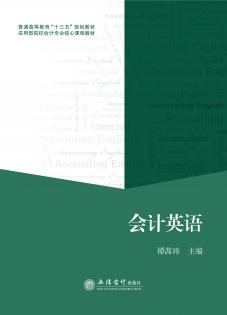Chaper 1 Introduction to accounting
第一章 会计导论
Learning objectives
1.Nature of accounting and business(会计和企业的本质)
2.Types and forms of businesses entity(商业实体的类型)
2.1 types of businesses(商业实体的类型)
2.2 Forms of business entities(商业实体的组织形式)
3.Why keep accounts(为什么要记账)
4.Finanacial accounting and management accounting(财务会计和管理会计)
4.1 Financial accounting(财务会计)
4.2 Management accounting(管理会计)
5.Users of accounting information(会计信息的使用者)
6.The regulatory framework(监管框架)
6.1 The regulatory system(监管制度)
6.2 The International Accounting Standards Board(IASB)(国际会计准则委员会)
6.3 International Financial Reporting Principles(GAAP)(国际财务报告准则)
6.4 Generally Accepted Accounting Principles(GAAP)(一般公认会计原则)
7.Accounting assumption(会计假设)
7.1 Going concern(持续经营)
7.2 Accruals basis(权责发生制)
8.The qualitative characteristics of financial
information(财务信息的质量特征)
8.1 Fundamental qualitative characteristics(基本质量特征)
8.2 Enhancing qualitaive characteristics(强化质量特征)
8.3 Other accounting concepts(其他会计概念)
Key terms
Notes to the text
Self-test questions
Exercises
Chapter 2 Accounting equation and double-entry accounting
第二章 会计等式和复式记账
Learning objectives
1.What is accounting elements(会计要素)
1.1 Assets(资产)
1.2 Liabilities(负债)
1.3 Owner's equity(所有者权益)
1.4 Income(收入)
1.5 Expenses(费用)
2.What is accounting equation(会计等式)
2.1 Transactions and events(经济业务与事件)
2.2 Source documents(原始凭证)
3.Double entry system(复式记账)
3.1 Dual effect (duality conceot)(复式记账的意义)
3.2 Debits and credits(借方和贷方)
3.3 The basic rules of double entry bookkeeping(复式记账法的基本规则)
3.4 Application of the double entry rule(复式记账法的应用步骤)
4.The use of double entry bookkeeping(复式记账法的实际运用)
4.1 Use of asset, liability,and owner's equity accounts
(复式记账法下,资产、负债和所有者权益账户的运用)
4.2 Use of revenue and expense accounts
(复式记账法下,收入和费用账户的运用)
Key terms
Notes to the text
Self-test questions
Exercises
Chapter 3 Accounting cycle I
第三章 会计循环 I
Learning objectives
1. Accounting cycle(会计循环)
1.1 Major steps in accounting cycle(会计循环的主要步骤)
1.2 Chart of accounts(科目表)
2. Journalizing(日记账)
3. Posting journal entries to accounts(过账)
4.Trial balance(试算平衡表)
4.1 Purpose of a trial balance(试算平衡表的用途)
4.2 Trial balance formal(试算平衡表的格式)
4.3 Example of a trial balance(举例说明)
4.4 Limitations(局限性)
Key terms
Notes to the text
Self-test questions
Exercises
Chapter 4 Accounting cycle Ⅱ
第四章 会计循环 Ⅱ
Learning objectives
1.The need for adjustment(调整的必要性)
1.1 Accruals basis and matching convention(权责发生制与配比原则)
1.2 Accounting period/fiscal year(会计年度/财政年度)
2.Making the adjustment ?:Accrued expenses(accruals)(调整的必要性)
2.1 Introduction(基本介绍)
2.2 Exaple 1:Accruals(举例1:应计费用)
2.3 Exaple 2:Accruals(举例2:应计费用)
3.Making the adjustment Ⅱ:Prepayments(调整Ⅱ:预付账款)
3.1 Introduction(基本介绍)
3.2 Example 1:Prepayments(举例1:预付账款)
3.3 Example 2:Prepayments(举例2:预付账款)
4.Making the adjustment Ⅲ:Unearned revenue(调整Ⅲ:预收账款)
4.1 Introduction(基本介绍)
4.2 Effect on profit and net assets:compared with prepayments and
unearned revenue(对利润和净资产的影响:与预付账款和预收账款相对比)
5.Making the adjustment Ⅳ:Depreciation(调整Ⅳ:折旧)
5.1 Introduction(基本介绍)
5.2 Requirements of IAS 16 for depreciation(IAS16 对折旧的相关规定)
5.3 Useful life(使用寿命)
5.4 Ledger entries for depreciation(折旧的会计分录)
6.Prepare the adjusted trial balance and financial
statements(编制调整后试算平衡表和财务报表)
6.1 Adjusted trial balance(调整后试算平衡表)
6.2 Preparing financial statements(编制财务报表)
Key terms
Notes to the text
Self-test questions
Exercises
Chapter 5 Carrent assets
第五章 流动资产
Learning objectives
1.Cash and cash equivalent(现金和现金等价物)
1.1 Chsh(现金)
1.2 Bank accounts(银行账户)
1.3 Bank statement and cash book(银行对账单和现金账簿)
1.4 The bank reconciliation(银行存款余额调节表)
1.5 What to look for when doing a bank
reconciliation(在做银行存款余额调节表时需要查找什么)
1.6 Special-purpose cash funds(特殊用途的现金基金)
2.Receivable(应收账款)
2.1 Classification of receivables(应收账款的分类)
2.2 The receivables ledger(应收账款账簿)
2.3 Allowance for receivables(应收账款的坏账准备)
2.4 Accounting treatment in the financial statements(财务报表中的会计处理)
2.5 Allowance for receivables:ledger accounting
entries(应收账款的坏账准备:账簿中的分录)
3.Inventory(存货)
3.1 Cost of goods sold(销货成本)
3.2 Valuing inventories(存货的估价)
Key terms
Notes to the text
Self-test questions
Exercises
Chapter 6 Fixed assets and intangible assets
第六章 固定资产和无形资产
Learning objectives
1.Define,classify,and account for the cost of fixed
assets(固定资产的定义,分类和核算)
1.1 Nature of fixed assets(固定资产的性质)
1.2 Classifying costs(成本的分类)
1.3 Capital and revenue expenditure(资本性和收益性支出)
2.Property,plant and equipment(不动产,厂房和设备)
2.1 Definitions(定义)
2.2 Initial measurement(初始计量)
2.3 Recognition in the accounts(账目的确认)
2.4 Components of cost(成本的构成要素)
3.Accounting for depreciation(折旧的核算)
3.1 What is depreciation(什么是折旧)
3.2 Factors in computing depreciation expense(影响折旧费用计算的因素)
3.3 Straight-line method(直线折旧法)
3.4 Units-of-output method(产量法)
3.5 Double-declining-balance method(双倍余额递减法)
3.6 Change in method of depreciation(折旧方法的改变)
3.7 Change in expected useful life or residual value of an
asset(资产预计使用年限或者残值的改变)
3.8 Depreciation is not a cash expense(折旧不是现金的支出)
3.9 Ledger entries for depreciation(折旧的分录)
4.Non-current asset disposals(非流动资产的处置)
4.1 What is the disposal of non-current assets(非流动资产的处置是什么)
4.2 The principles behind calculating the profit or loss on
disposal(处置时计算损益的原则)
5.Intangible assets(无形资产)
5.1 Definition(定义)
5.2 Accounting treatment(会计处理)
5.3 Research and development costs(研究与开发成本)
Key terms
Notes to the text
Self-test questions
Exercises
Chapter 7 Liabilities
第七章 负债
Learning objectives
1.Current liabilities(流动负债)
1.1 Short-term loans and overdraft(短期贷款和透支)
1.2 Accounts payable(应付账款)
1.3 Notes payable(应付票据)
1.4 Interest payable( 应付利息)
1.5 Salaries payable(应付职工薪酬)
1.6 Income tax payable(应付所得税)
1.7 Unearned revenue(预收款项)
1.8 Current maturities of long-term debt(一年内到期的长期债务)
2.Non-current liabilities(非流动负债)
2.1 Bonds payable(应付债券)
2.2 Long-term notes payable(长期应付票据)
2.3 Lease liabilities(租赁负债)
3.Contingencies(或有事项)
4.Reporting of liability(负债的报告形式)
4.1 Reporting of current liability(流动负债的报告形式)
4.2 Reporting of non-current liability(非流动负债的报告形式)
Key terms
Notes to the text
Self-test questions
Exercises
Chapter 8 Owner's Equity
第八章 所有者权益
Learning objectives
1.The definition and classification of equity(权益的定义和分类)
2.Corporate capital(公司资本)
2.1 Paid-in capital(实收资本)
2.2 Retained earnings(留存收益)
3.Issuance of stock(股票的发行)
3.1 Issuing par value common stock for cash(发行有面额现金普通股)
3.2 Issuing no-par common stock for cash(发行无面额现金普通股)
4.Preferred stock(优先股)
5.Treasury stock(库存股)
5.1 Purchase of treasury stock(购买库存股)
5.2 Disposal of treasury stock(处置库存股)
6.Dividends and stock splits(股息和股票分割)
6.1 Cash dividends(现金股利)
6.2 Stock dividends(股票股利)
6.3 Stock splits(股票分割)
7.Retained earning(留存收益)
8.Earnings per share(EPS)(每股收益)
Key terms
Notes to the text
Self-test questions
Exercises
Chapter 9 Balance sheet and income statement
第九章 资产负债表和利润表
Learning objectives
1.Financial statements(财务报表)
1.1 Understanding of financial statements(对财务报表的理解)
1.2 Breaking down financial statements(财务报表的组成)
1.3 Users of financial statements(财务报表的使用者)
2.Balance sheet(资产负债表)
2.1 Definitions and explanations(定义与解释)
2.2 Format of income statement(资产负债表的格式)
2.3 Items of income statement(利润表的内容)
3.Income statement(利润表)
3.1 Definitions and explanations(定义与解释)
3.2 Format of income statement(利润表的格式)
3.3 Items of income statement(利润表的内容)
3.4 The relationship between balance sheet and income
statement(资产负债表与利润表的关系)
4.Ratio analysis of financial statements(财务报表的比率分析)
4.1 Profitability ratios(盈利能力比率)
4.2 Liquidity ratios(流动性比率)
4.3 Solvency ratios(偿债能力比率)
4.4 Efficiency ratios(营运能力比率)
4.5 Advantages and disadvantages of ratio analysis(比率分析的优缺点)
Key terms
Notes to the text
Self-test questions
Exercises
Chapter 10 statement of cash flows
第十章 现金流量表
Learning objectives
1.Introduction(本章介绍)
2.Cash and cash equivalents(现金和现金等价物)
3.IAS 7 Statement of cash flows(国际会计准则第7号现金流量表)
3.1 Format of statement of cash flows(现金流量表的形式)
3.2 Cash flows from operating activities(经营活动产生的现金流量)
3.3 Cash flows from investing activities(投资活动产生的现金流量)
3.4 Cash flows from financing activities(筹资活动产生的现金流量)
4.Other points(其他方面)
5.Conclusion(结论)
Key terms
Notes to the text
Self-test questions
Exercises
Appendix 1 Fiscal 2018 Annual Report of ESTEE LAUDER to
Stockholders
附录1 雅诗兰黛2018年年报
Appendix 2 Fiscal 2018 Annual Report of Apple Inc.
附录2 苹果2018年年报
Appendix 3 Fiscal 2018 Annual Report of Walmart Inc.
附录3 沃尔玛2018年年报
Reference
参考文献



















